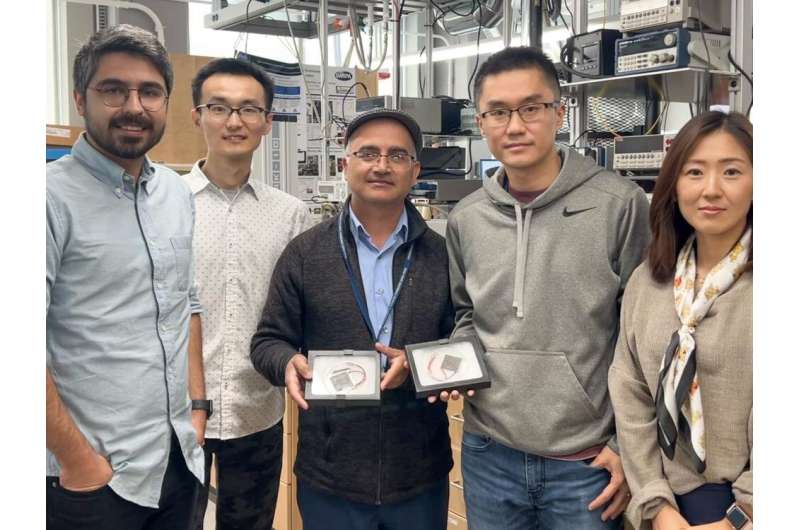Researchers enhance conversion efficiency of thermoelectric devices

In the effort to reduce our reliance on fossil fuels, one strategy involves harvesting the waste heat that is already being produced by our energy systems. Thermoelectric generators can convert waste heat to clean electricity, and a new design breakthrough may make these devices more efficient than previously possible, according to scientists at Penn State and the National Renewable Energy Laboratory.
“We have developed a unique materials design that can push the conversion efficiency of thermoelectric devices up to 15%,” said Wenjie Li, assistant research professor in the Department of Materials Science and Engineering at Penn State. “This is the highest efficiency that has been recorded so far using this kind of thermoelectric technology.”
Penn State researchers have been working to improve the performance of thermoelectric generators—devices that can convert differences in temperature to electricity. When the devices are placed near a heat source—like a steam pipe in a power plant—charge carriers, like electrons, moving from the hot side to the cold side produce an electric current. Thermoelectric devices have no moving parts and produce no chemical reactions or emissions, offering a promising source of clean energy, the scientists said.
The team has developed a new method for creating functionally graded materials in thermoelectric devices that enabled them to achieve 15.2% efficiency in a single-leg device with a temperature change of 670 degrees Kelvin (roughly 1,206 degrees Fahrenheit). Current commercially available devices boast 5% to 6% efficiency.
The findings, recently published in the journal Advanced Materials, suggest the new approach could have a transformative impact on the design and development of next-generation thermoelectric devices, the scientists wrote.
“Because of global greenhouse gas emissions and the associated environmental issues, we want to move toward greener technologies,” said Bed Poudel, research professor in the Department of Materials Science and Engineering at Penn State. “This work making thermoelectric devices more efficient can help with that goal.”
Conventional thermoelectric generators have segmented designs to optimize performance on the higher- and lower-temperature sides of the device. These are often different types of materials that must be created separately and joined together by brazing or soldering. But this creates a heterogeneous interface that can reduce the device’s efficiency, the scientists said.
The new approach eliminates the need for that interface because the higher- and lower-temperature side materials are created together in a single step.
“The basic idea is to integrate two or more layers using the same material family but with a slight difference in chemical compositions,” Li said. “And by doing so, we can create the functionally graded materials in one step, and we don’t need any brazing or soldering techniques to join them eliminating the heterogeneous interface.”
The researchers used a process called electrical and mechanical field-assisted sintering to create the materials. Also known as spark-plasma sintering, the technique uses electric current and pressure to compress fine powders into a solid mass of material. Spark-plasma sintering allows scientists to create functionally graded materials by placing powders one underneath another, and to tailor those layers by adding dopants, or ingredients that can change a material’s properties. This enabled the team to optimize the chemical compositions of the higher- and lower-temperature sides while using materials from the same family that can be sintered at similar temperatures in one step.
And because the materials are from the same family, they have closely matched thermal expansion and other mechanical properties, meaning the devices will have long operational life compared to conventional segmented devices, the scientists said.
“One requirement to achieve maximum conversion efficiency is that the optimum current going through the entire device is the same for the high-temperature and low temperature side,” Li said. “But in the conventional design, since we used different materials systems, the electrical resistivity of these two materials may be significantly different.”
Thermoelectric devices resemble a table with two legs—one leg made of p-type and one of n-type semiconductor material. The current study only applies to the p-type material, and the scientists said further work to apply this to the n-type could result in additional increases in efficiency.
Other additional work will focus on creating additional layers of the leg, each optimized for a different temperature range, using the one-step sintering approach, which could also further improve efficiency.
“What we demonstrated by generating 15% conversion efficiency is now this technology is very much competitive with other power generation technologies at the smallest scale—like small diesel generators or even solar panels,” Poudel said. “We show heat energy can be converted into electricity in a competitive way with those technologies.”
More information:
Wenjie Li et al, Toward High Conversion Efficiency of Thermoelectric Modules through Synergistical Optimization of Layered Materials, Advanced Materials (2023). DOI: 10.1002/adma.202210407
Citation:
Researchers enhance conversion efficiency of thermoelectric devices (2023, May 1)
retrieved 1 May 2023
from https://techxplore.com/news/2023-05-conversion-efficiency-thermoelectric-devices.html
This document is subject to copyright. Apart from any fair dealing for the purpose of private study or research, no
part may be reproduced without the written permission. The content is provided for information purposes only.
For all the latest Technology News Click Here
For the latest news and updates, follow us on Google News.

